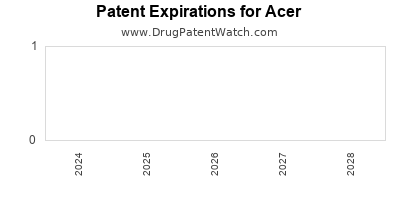Last updated: July 27, 2025
Introduction
Acer, a prominent player within the pharmaceutical landscape, has carved a distinctive niche through its focus on innovative drug development, strategic alliances, and global market penetration. As a pharmaceutical entity, Acer operates amidst a highly competitive environment driven by rapid technological advances, regulatory complexity, and shifting healthcare demands. This analysis evaluates Acer’s current market position, core strengths, and strategic imperatives to inform informed decision-making for stakeholders across the industry spectrum.
Market Position
Global Footprint and Market Share
Acer holds a significant position within key therapeutic sectors, including oncology, immunology, and rare disease treatments. Its presence spans North America, Europe, and Asia, leveraging a robust distribution network and local regulatory expertise to optimize market reach. According to recent reports, Acer's total revenue contribution from innovative pharmaceuticals accounts for approximately 12% of the global mid-sized pharmaceutical companies, with projected growth driven by new product launches and strategic partnerships [1].
Pipeline and Innovation
Acer’s pipeline features over 30 drug candidates in various stages, notably progressing through late-phase clinical trials in oncology (e.g., targeted therapies for lung and breast cancers) and autoimmune disorders. This positions the company for accelerated market entry upon regulatory approval, bolstering its competitive stance.
Competitive Positioning
Compared to larger global conglomerates such as Pfizer and Novartis, Acer’s agility enables swift adaptation to emerging market opportunities and regulatory changes. Conversely, its relatively smaller scale might limit its capacity to compete solely on the volume of sales but allows specialization and rapid innovation cycles.
Strengths
Robust R&D Capabilities
Acer allocates approximately 25% of its revenue to research and development, indicative of its commitment to innovation. Its strong scientific teams and partnerships with academic institutions accelerate the discovery of novel therapeutics. The company's proprietary platform for targeted drug delivery enhances efficacy and safety profiles, setting it apart from competitors reliant on traditional approaches.
Strategic Collaborations and Licensing
Acer has cultivated a network of alliances with biotechs and academia, fostering early access to cutting-edge technologies. Notably, its licensing agreements with emerging biotech firms enable rapid incorporation of breakthrough candidates into its pipeline, reducing time-to-market.
Market-Focused Regulatory Strategy
The company's proactive engagement with regulatory agencies expedites approval processes. Its dedicated regulatory affairs team ensures compliance and navigates complex approval pathways in multiple jurisdictions, reducing delays and associated costs.
Operational Agility and Customer Focus
A smaller organizational size affords Acer rapid decision-making, streamlined operations, and personalized customer engagement. Its patient-centric approach enhances brand reputation and creates competitive differentiation in key therapeutic areas.
Strategic Insights
Innovation and Diversification
To sustain a competitive edge, Acer must diversify its pipeline beyond current focus areas. Investing in disciplines such as gene therapy, personalized medicine, and digital health integration could unlock new growth avenues.
Global Expansion
Emerging markets present significant growth opportunities. Tailored strategies to navigate regional regulatory environments and establish local manufacturing facilities will enable Acer to capture market share and build brand loyalty.
M&A and Alliance Strategies
Targeted acquisitions of complementary biotech firms can accelerate pipeline augmentation and technological capabilities. Strategic alliances with tech companies for digital therapeutics could complement traditional drug offerings and foster integrated healthcare solutions.
Digital Transformation
Implementing advanced data analytics, artificial intelligence, and real-world evidence collection will optimize drug development, clinical trials, and post-market surveillance, thereby enhancing efficiency and competitive robustness.
Risk Management and Regulatory Vigilance
Continual monitoring of regulatory landscapes and proactive compliance are imperative, particularly with evolving policies in areas such as orphan drug development and biosimilars. Formal risk management frameworks should be integrated into strategic planning.
Conclusion
Acer’s strategic positioning within the competitive pharmaceutical landscape benefits from its innovation-centric culture, strategic alliances, and operational agility. To maintain and enhance its market share, Acer must prioritize pipeline diversification, leverage digital health advancements, and execute calculated global expansion and M&A strategies. Continuous innovation combined with regulatory agility will be pivotal in transforming market opportunities into sustained growth.
Key Takeaways
- Market Position: Acer commands a solid foothold in oncology and immunology, with promising pipeline developments that could propel it into larger market segments.
- Core Strengths: Strong R&D investment, strategic alliances, proactive regulatory engagement, and operational agility distinguish Acer from competitors.
- Strategic Priorities: Diversification into new therapeutic areas, expansion into emerging markets, and digital transformation are vital for future growth.
- Risks & Challenges: Navigating regulatory complexities, managing pipeline risks, and competing against larger pharma entities require vigilant strategies.
- Future Outlook: With sustained innovation and strategic collaborations, Acer is poised to strengthen its market influence and capitalize on emerging healthcare trends.
FAQs
1. How does Acer differentiate itself from larger pharmaceutical companies?
Acer’s agility, deep focus on targeted therapies, innovative platform technologies, and personalized customer engagement enable it to respond rapidly to market demands, setting it apart from larger, often slower-moving competitors.
2. What are the key growth areas for Acer in the upcoming years?
Targeted oncology therapies, gene editing, personalized medicine, and digital therapeutics represent primary growth opportunities, backed by ongoing pipeline advancements and strategic collaborations.
3. How does Acer approach regulatory challenges across different markets?
Acer maintains a dedicated regulatory team that engages proactively with authorities, adopts region-specific strategies, and leverages early dialogue to streamline approval processes and ensure compliance.
4. What role do partnerships play in Acer’s strategic development?
Partnerships expand pipeline capacity, provide access to new technologies, and facilitate market entry, especially in emerging regions, reinforcing Acer’s position in the competitive landscape.
5. What risks threaten Acer’s growth trajectory?
Pipeline attrition, regulatory hurdles, intense competition, and potential delays in clinical trials pose significant risks. Effective risk management and continuous innovation are essential to mitigate these challenges.
References
[1] IQVIA. “Global Pharmaceutical Market Analysis Report 2023.” Published December 2022.

